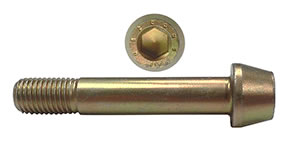
Bolts come in a variety of styles. While most of these styles consist of a solid head with a fixed number of edges, some of them feature a drive recess within the head. Known as internal wrenching bolts, they are commonly used in machinery, automotive and aerospace fastening applications.
Overview of Internal Wrenching Bolts
An internal wrenching bolt is a type of threaded fastener with a drive recess within the head. All bolts have a shank and head — and internal wrenching bolts are no exception. Only internal wrenching bolts, however, have a recess that allows for the insertion of a hex key or similar wrench.
Here are some common features of a typical internal wrenching bolt:
- Partially threaded shank
- Flat, non-pointed tip
- Six-sided recess within the head
- Uniform threading (coarse or fine)
How to Install an Internal Wrenching Bolt
You’ll typically need a hex key to install an internal wrenching bolt. Hex keys are handheld drivers with six sides. Placing a hex key in the internal wrenching bolt’s head and turning it clockwise will tighten the bolt. Turning the hex key counterclockwise, conversely, will loosen or remove the internal wrenching bolt.
Benefits of Internal Wrenching Bolts
Internal wrenching bolts offer several benefits, one of which is ease of installation in tight spaces. You may not have the luxury of using a traditional wrench or socket driver in a tight space. A hex key, though, requires less space to use. You can easily position the hex key in the internal wrenching bolt’s head to tighten and install the bolt.
Internal wrenching bolts are better protected from damage during installation and removal than other types of bolts. They feature a recess with six sides. The close fit between the hex key and the six-sided recess helps to prevent slippage and subsequent damage to the internal wrenching bolt.
Another benefit of internal wrenching bolts is high torque transmission. Torque transmission is the turning force that’s transferred to a bolt or screw during installation or removal. The higher the torque transmission, the easier it will be to install or remove the fastener.
You can find internal wrenching bolts available in different materials. Some of them are made of stainless steel or carbon steel. Others are made of titanium. There are even cadmium-plated internal wrenching bolts that offer a superior level of protection against corrosion and degradation. Cadmium-plated internal wrenching bolts are typically made of steel alloy, but they feature a layer of cadmium on the exterior.



